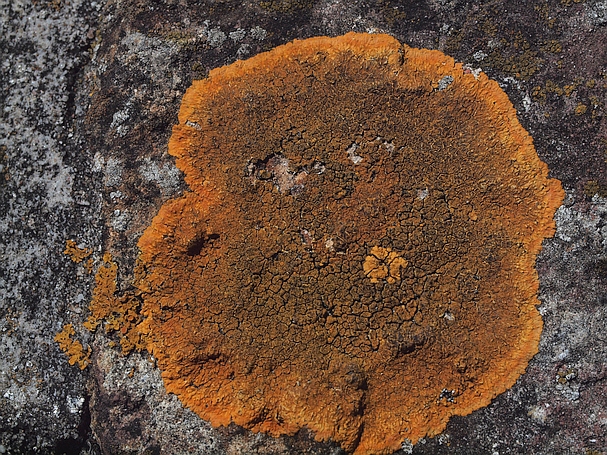Platte citroenkorst (Variospora aurantia)

Het
thallus van de platte citroenkorst is helder oranje van kleur en dof
van tint. Dit korstmos heeft de vorm van een rozet met afgeplatte en
tamelijk brede (1.5 tot 3 mm) randlobben, die dicht tegen het substraat
aanliggen. Nabij de rand van het thallus is vrij vaak een witte zone
aanwezig. Het centrum van het thallus is in eilandjes opgesplitst
en meestal wat donkerder van kleur dan de rand. Bij het centrum zijn
vaak ook apotheciŽn aanwezig, die dezelfde kleur hebben als het thallus
[10]. De soort is stikstofminnend, zonminnend, warmteminnend en
droogteminnend [8]. Volgens een IsraŽlisch artikel is de groeisnelheid
van thalli die al enkele centimeters groot zijn 0,37 millimeter per
jaar en kunnen de thalli honderden jaren oud worden [7]. Thalli van de
platte citroenkorst nemen zware metalen op uit de lucht en uit
aangewaaid stof, waardoor zulke metalen tot hoge concentraties in dit
korstmos kunnen ophopen [4-6]. De oranje kleur van de thalli is te
wijten aan de aanwezigheid van carotenoÔden. De samenstelling van deze
kleurstoffen is vastgesteld [1,2]. De algpartner in de platte
citroenkorst is een Trebouxia
soort [3]. In Nederland is de platte citroenkorst een tamelijk zeldzame
korstmos-soort, die volgens de veldgids van de KNNV vooral groeit op
kalkhoudend gesteente van oude vestingwerken, kerken [9], grafzerken,
en de beschoeiing van dijken langs het IJsselmeer. In Limburg groeit
dit korstmos ook op rotsen van tufkrijt.
Naam
De genusnaam Variospora betekent "met verschillende sporen", de genusnaam aurantia "oranjekleurig". Caloplaca aurantia is een synoniem van Variospora aurantia.
Waar gevonden
We hebben thalli van de platte citroenkorst aangetroffen op de muren van de Jacobaburcht, een vestingwerk in Oostvoorne.
Literatuur
1.
Czeczuga B, Grillo M, Czeczuga-Semeniuk E (1999) Carotenoid content in
the thalli of 34 lichen species from Sicily. Feddes Rep 110:561-568.
2.
Czeczuga B, Kilias H, Czeczuga-Semeniuk E, Muhr LE, Lumbsch HT,
Hestmark G (2000) Carotenoids in the thalli of lichen species from
Central Europe. J Hattori Bot Lab 89:299-311.
3. Garty J (1988) Some observations on the establishment of the lichen Caloplaca aurantia on concrete tiles in Israel. Studia Geobotanica 8:13-21.
4. Garty J, Galun M, Fuchs C, Zisapel N (1977) Heavy metals in the lichen Caloplaca aurantia from urban, suburban and rural regions in Israel (a comparative study). Water, Air and Soil Pollution 8:171-188.
5. Garty J, Galun M, Hochberg Y (1986) The accumulation of metals in Caloplaca aurantia growing on concrete roof tiles. Lichenologist 18:257-263.
6.
Garty J, Galun M, Kessel M (1979) Localization of heavy metals and
other elements accumulated in the lichen thallus. New Phytol 82:159-168.
7. Lange LO (1990) Twenty-three years of growth measurements on the crustose lichen Caloplaca aurantia in the Central Negev desert. Israel J Plant Sci 39:383-394.
8. Soun J, VondrŠk J (2008) Caloplaca aurantia and Caloplaca flavescens (Teloschistaceae, lichen-forming fungi) in the Czech Republic with notes to their taxonomy and nomenclature. Czech Mycol 60:275-291.
9.
Sparrius LB, Aptroot A, Van Herk K (2007) Diversity and ecology of
lichens on churches in the Netherlands. Nova Hedwigia 85:299-316.
10. Sussey JM, Baubet R (2005) Caloplaca aurantia. In: Les Fiches du dťbutant (3Ťme serie). Bull Ass Fr Lichťnologie 30:26-27.
Terug naar de soortenlijst
